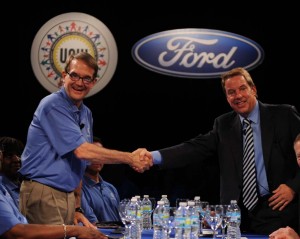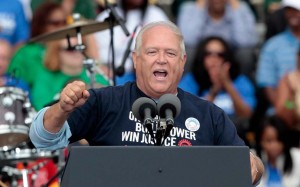
Past UAW President Bob King shakes hands with Ford Chairman Bill Ford as negotiations began in 2011 on the now expiring contract.
The overall economic impact of the negotiations between the domestic carmakers and the United Auto Workers on wages across the U.S. has waned over the years, but the inherent drama of the talks lives on as the two sides get down to bargaining this year and the stakes are as high as ever.
The negotiations, which open today with an official handshake between General Motors executives and top UAW officers, promise to particularly eventful – and unpredictable – because of the climate change that surrounds the 2015 negotiations.
After all these are the first negotiations since the 1990s that follow a streak of five very profitable years, noted Kristin Dziczek, an analyst with Center for Automotive Research in Ann Arbor.
Indeed, the last time these conditions prevailed back in 1999, the union gained what was described as one of its richest contracts ever. The 1999 contract was also deeply reviled on Wall Street and ultimately became a potent symbol of mis-management and profligate ways of Detroit’s automakers. The notion was reinforced a half decade later when the Detroit Three automakers skidded into deep financial trouble and two – GM and Chrysler – wound up in bankruptcy court.
But the 2015 negotiations will occur out of the shadow of bankruptcy as all remaining terms of the bankruptcy will have expired by the time the current labor agreements end in mid-September. Meanwhile, executives GM and Chrysler, now FCA U.S., are loathe to discuss the bankruptcy era in public as their rebuild their images.
“There is nothing to suggest this will be a concessionary agreement,” noted Dziczek. “Strikes are possible, but the UAW’s organizing drives in the south may moderate the antagonism.”
The union agreed to concessions under duress in 2007 and again in 2009 when both GM and Chrysler, now FCA U.S. were both in bankruptcy. The concessions required the union to give up cost-of-living adjustments and accept higher co-pays and deductibles for health care. The negotiations in 2011 preserved the status since the union was barred from striking under the terms of the federal bailout.
UAW president Dennis Williams has said he expects the union to obtain a fair share of the industry’s recovery this time around. In public, Williams has emphasized he was looking to increase the pay of both new hires and so-called legacy workers right across the board.
“We’ve been able to achieve some great things in the past few years. As you look around the industry, we see a lot of new products and new processes that have made these companies a lot of money,” Williams noted during a recent meeting with reporters at union headquarters in Detroit. “The UAW helped the entire industry get back on its feet.”
The union wants a raise for the 140,000 union members covered by the contract is looking at different models for “bridging the gap” in pay between legacy workers making $30 per hour and new hires who make roughly $16.50 under the current contract.
(UAW ready to help automakers with health-care costs. For more, Click Here.)
Williams said that while he wants to avoid a confrontation, but he is prepared or the worst.
“I never go into negotiations without being prepared,” Williams said. “But we believe we can get through collective bargaining without a confrontation. It’s not really on my mind. We’ve raised dues to build up the strike fund, (but) the last thing we want is for our members for their families or their communities is to go through that.”
Cindy Estrada, the union’s top bargainer at GM said recently, “If there is a strike, both of us will have failed.”
But union also has also moderated its pre-negotiation rhetoric. When Ford last week announced plans to move production of the Ford Focus to Mexico, the union’s response was strikingly modest.
“We are extremely confident that a new product commitment will be secured during the upcoming 2015 negotiations and that the Michigan Assembly Plant will maintain a full production schedule,” UAW vice president Jimmy Settles, the union’s top Ford negotiator, said in a letter to members of UAW Local 900 that was also posted on Facebook
“In spite of this announcement, we want to ensure both the membership of Local 900 and the community that UAW members will continue to produce world-class quality vehicles with pride and passion now and beyond 2018, which remains a tradition of all United Auto Workers,” he said.
But the labor peace that has prevailed during the past decade is being tested. Last month, workers at a key parts plant that once belong to Ford, but is now operated by Faurecia, rejected a proposed agreement that included a raise by a decisive margin.
(Click Here to see how the departure of some of the automakers top negotiators will impact contract talks.
In March, 41 workers were fired – and later re-instated at the union’s insistence – after a demonstration and protest over work rules in the plant. Meanwhile complaints about the miniscule profit sharing checks and rotating shifts have rippled through FCA U.S. plants.
Williams, however, has also said he is prepared to work with the automakers on some key issues, notably health care and wages for new employees where a grow-in period could maintain a low starting point but permit workers to reach parity with long-term employees over a fixed period of time.
But Detroit’s automakers, who are facing competition from all over the world and a pool of potential buyers, that in relative terms, has been shrinking rather than growing, are seeking to hold the line on labor costs. The differences between the two sides appear stark.
Sergio Marchionne, the bombastic chief executive of Fiat Chrysler Automobiles NV, has insisted repeatedly the industry needs a new contract model, insisting the old one doesn’t work and profit sharing and incentive bonuses should become a larger part of the pay package of each worker.
Despite restructuring since the 2009 recession, GM and Ford still have higher labor costs than their major competitors such as Honda and Toyota. The $10 per hour labor cost gap between GM and Toyota Motor Corp translates to roughly $250 in additional labor costs for GM, according to a recent study by the Center for Automotive Research.
Marchionne is seeking to defend Fiat advantage that comes with the lower starting wage. Since 43% of the company workers now workers earn the lower entry-level wage, nearly double the percentage of such workers at Ford and GM.
In contrast to Marchionne’s pronouncements about the need for change, GM has mounted something of a charm offensive ahead of the company negotiations announcing plans to spend money on new equipment at plants in Michigan, Texas and Kansas. Before the company’s annual shareholders meeting, GM Chief Executive Mary Barra declined to discuss GM’s specific goals for the talks saying that should be left to the bargaining table.
Ford has also been non-committal in its discussions of the talks.
(To see if the move of small car production to non-union plants will impact talks, Click Here.)
“Our approach going into the contract (negotiations) is to make sure that we have a fair and competitive agreement that allows us to provide jobs for our people but will allow us to remain competitive and invest here in the U.S. jobs in the U.S.,” Ford Chief Executive Officer Mark Fields told reporters recently.


There was never any basis to conclude that the UAW agreement led to the mismanagement of the auto companies or their financial issues. This was due mostly to bad management and an economic recession, not to labor costs. It should be obvious that for labor to keep pace with inflation, every new contract should be the “richest” in history because the cost of living continues to climb. If the compensation and benefits don’t keep pace then labor is going backwards while corporate profits and executive compensation skyrockets. It wasn’t labor that mismanaged the businesses but they are the ones who suffered for the mismanagement as did retirees who got screwed out of their full pension benefits.
The reason why car companies build in the Southern U.S. is because they can pay substandard compensation to people living in an economically depressed geographic area. There is no reason what so ever that auto workers in the South should not receive virtually the same compensation as auto workers in Detroit or elsewhere. It’s completely unscrupulous to pay workers in the South $15 hour when they should be paid the same as UAW elsewhere. Financial greed is what drives most companies and the execs are often paid disproportionate to their performance and contributions to the companies revenue generation streams.